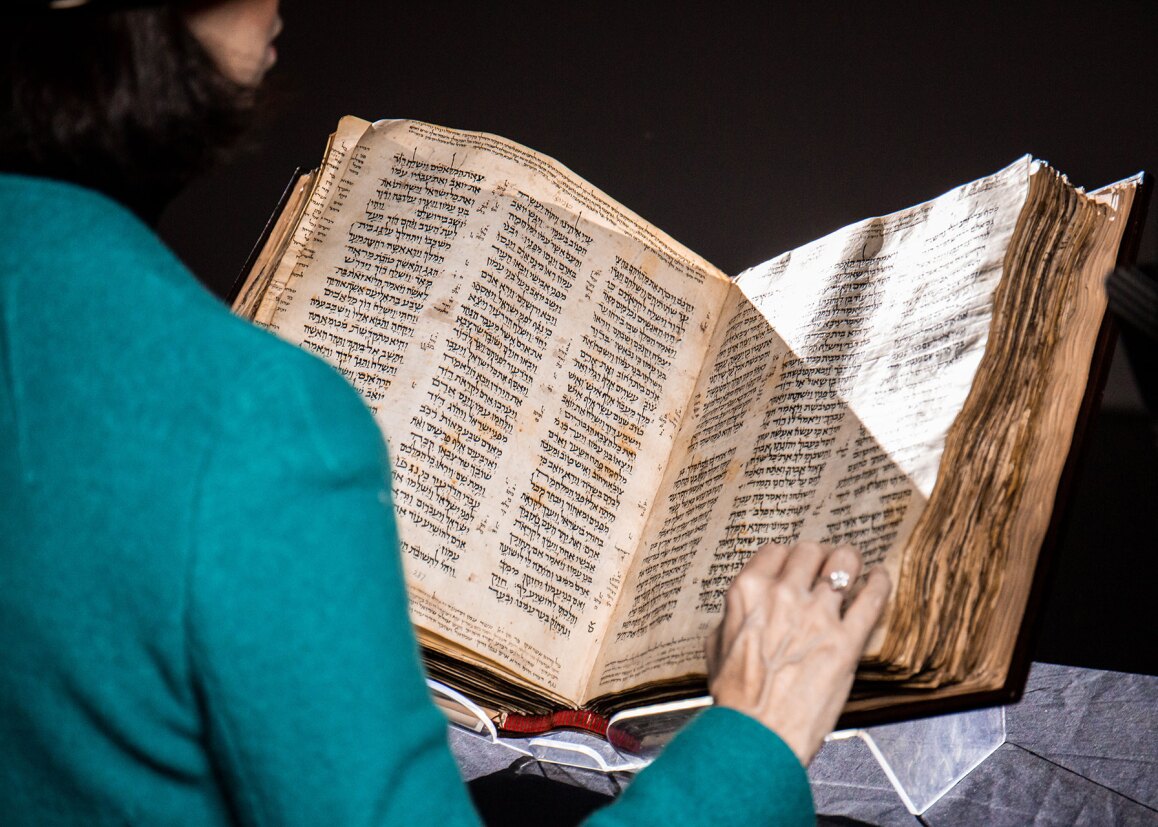O ver a thousand years ago, after seven centuries of near-total silence, the creation of Hebrew manuscripts exploded with a thrilling flourish. The last of the Dead Sea Scrolls – the most important surviving ancient Judaic manuscripts – date to the 1st century C.E., and it wasn’t until the early Middle Ages that scholars known as Masoretes began to create a body of notes that standardized the text of the Hebrew Bible, which had remained in flux since antiquity.
One of the most well-known books to emerge from this project was the Aleppo Codex, assembled circa 930. It was later completed with Masoretic notes by Aaron ben Moses ben Asher, a preeminent Bible scholar responsible for correcting the Codex to match the tradition he’d inherited about how the words should be spelled, vocalized and accented. The Aleppo Codex subsequently served as an exemplar for scribes to ensure that they’d copied the Bible properly. Today, unfortunately, fewer than 300 of the approximately 487 original folios of the Aleppo Codex survive.
The Hebrew Bible is the most influential book in human history and the bedrock of Western civilization.
The earliest, most complete copy of the Hebrew Bible is actually a book known as Codex Sassoon, named for its most prominent modern owner: David Solomon Sassoon (1880–1942), a passionate collector of Judaica and Hebraic manuscripts. Dating to the late 9th or early 10th century, Codex Sassoon contains all 24 books of the Hebrew Bible – missing only 12 leaves – and precedes the earliest entirely complete Hebrew Bible, the Leningrad Codex, by nearly a century. On 17 May 2023, when it comes to the block at Sotheby’s with an estimate of $30 to 50 million, Codex Sassoon could become the most valuable historical document ever sold at auction.
Significantly, Codex Sassoon contains faithful notes of the Masorah, commentary that ensures the biblical text’s proper inscription and recitation. One such note refers to “the great teacher, Aaron ben Moses ben Asher” and his work on al-taj, the traditional honorific of the Aleppo Codex, suggesting the Masorete scribe who copied the Masorah of Codex Sassoon may have consulted the revered volume when it resided in Tiberias or Jerusalem in the 10th or 11th century.
Although scholars have been aware of its importance since the late 1960s, Codex Sassoon has remained largely out of public view for centuries; its last appearance was 40 years ago. A global tour will see the magnificent volume return to display, beginning with an exhibition 22–28 February at Sotheby’s in London, followed by stops in Tel Aviv (where it will be shown at ANU Museum of the Jewish People), Dallas, Los Angeles and New York City.
“The Hebrew Bible is the sacred, foundational text for peoples across the globe,” says Sharon Liberman Mintz, a Senior Judaica Specialist in Sotheby’s Books & Manuscripts Department. The 24 books, divided into three parts, contain the canonical Hebrew Scriptures: the Torah, the Nevi’im and the Ketuvim. Christians revere the texts as the Old Testament and Islam teaches that the Torah and the Psalms are divinely revealed books. Arguably, the Hebrew Bible constitutes the most influential book in human history and the bedrock of Western civilization.
“Codex Sassoon is a transformative witness to how the Hebrew Bible has influenced the pillars of civilization – art, culture, law, politics – for centuries.”
It’s difficult to overstate the significance of Codex Sassoon in particular, whose existence spans over a millennium of human history. “In Codex Sassoon, a monumental transformation in the history of the Hebrew Bible is revealed,” continues Mintz. “The biblical text in book format marks a critical turning point in how we perceive the history of the Divine word across thousands of years and is a transformative witness to how the Hebrew Bible has influenced the pillars of civilization – art, culture, law, politics – for centuries.”
Not only does the Codex provide critical insight into the development and spread of Abrahamic religions as well as the broader transition from oral to literary traditions, its centuries of annotations and inscriptions bear witness to the history of the Levant in the Middle Ages.

Early notes attest to the book’s travels and its sale from Khalaf ben Abraham to Isaac ben Ezekiel al-Attar, who later transferred ownership to his two sons, Ezekiel and Maimon. In the 13th century, the Codex was dedicated to the synagogue of Makisin, in present-day Syria, where it was likely rebound for the first time. Little is known about the Jewish community in Makisin, but given the cost of producing such prized manuscripts, it must have been prominent. The town of Makisin was destroyed, either by the Mongol Empire in the 13th century or the Timurid Empire in 1400, and the Codex was entrusted for safekeeping to Salama ibn Abi al-Fakhr, who was required to return it once the synagogue was rebuilt.
With the synagogue as yet unreconstructed, the Codex’s odyssey continued, until it was acquired in 1929 by Sassoon, who affixed his bookplate to the inside cover of the binding. Shaul Seidler-Feller, a Judaica consultant in Books & Manuscripts, comments: “David Solomon Sassoon built one of history’s most important private libraries of Judaica manuscripts, and Codex Sassoon undoubtedly ranks among the jewels of his collection.”
Codex Sassoon is a landmark for understanding the evolution of the history of the Hebrew Bible, and its appearance at auction this May represents the latest chapter in an incredible story of cultural transmission and heritage. “Codex Sassoon has long held a revered and fabled place in the pantheon of surviving historic documents and is undeniably one of the most important and singular texts in human history,” says Richard Austin, Sotheby’s Global Head of Books & Manuscripts. “With such eminence, the Codex has an incomparable presence and gravitas that can only be borne from more than one thousand years of history.”







